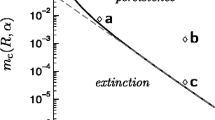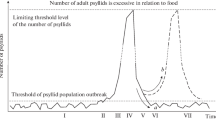Abstract
Knowledge about large-scale and long-term dynamics of (natural) populations is required to assess the efficiency of control strategies, the potential for long-term persistence, and the adaptability to global changes such as habitat fragmentation and global warming. For most natural populations, such as pest populations, large-scale and long-term surveys cannot be carried out at a high resolution. For instance, for population dynamics characterized by irregular abundance explosions, i.e., outbreaks, it is common to report detected outbreaks rather than measuring the population density at every location and time event. Here, we propose a mechanical-statistical model for analyzing such outbreak occurrence data and making inference about population dynamics. This spatio-temporal model contains the main mechanisms of the dynamics and describes the observation process. This construction enables us to account for the discrepancy between the phenomenon scale and the sampling scale. We propose the Bayesian method to estimate model parameters, pest densities and hidden factors, i.e., variables involved in the dynamics but not observed. The model was specified and used to learn about the dynamics of the European pine sawfly (Neodiprion sertifer Geoffr., an insect causing major defoliation of pines in northern Europe) based on Finnish sawfly data covering the years 1961–1990. In this application, a dynamical Beverton–Holt model including a hidden regime variable was incorporated into the model to deal with large variations in the population densities. Our results gave support to the idea that pine sawfly dynamics should be studied as metapopulations with alternative equilibria. The results confirmed the importance of extreme minimum winter temperatures for the occurrence of European pine sawfly outbreaks. The strong positive connection between the ratio of lake area over total area and outbreaks was quantified for the first time.
Similar content being viewed by others
References
Austarå, Ö., 1971. Cold hardiness in eggs of Neodiprion sertifer (geoffroy) (Hym., Diprionidae) under natural conditions. Nor. Entomol. Tidsskr. 18, 45–48.
Berliner, L.M., 2003. Physical-statistical modeling in geophysics. J. Geophys. Res. 108, 8776.
Buckland, S.T., Newman, K.B., Thomas, L., Koesters, N.B., 2004. State-space models for the dynamics of wild animal populations. Ecol. Model. 171, 157–175.
Campbell, E.P., 2004. An introduction to physical-statistical modeling using Bayesian methods. Technical Report 49, CSIRO Mathematical & Information Sciences, Australia.
Chilès, J.-P., Delfiner, P., 1999. Geostatistics. Modeling Spatial Uncertainty, Wiley, New York.
Dungan, J.L., Perry, J.N., Dale, M.R.T., Legendre, P., Citron-Pousty, S., Fortin, M.-J., Jakomulska, A., Miriti, M., Rosenberg, M.S., 2002. A balanced view of scale in spatial statistical analysis. Ecography 25, 626–640.
Dwyer, G., Dushoff, J., Yee, S.H., 2004. The combined effects of pathogens and predators on insect outbreaks. Nature 430, 341–345.
Geritz, S.A.H., Kisdi, E., 2004. On the mechanistic underpinning of discrete-time population models with complex dynamics. J. Theor. Biol. 228, 261–269.
Grimm, V., Revilla, E., Berger, U., Jeltsch, F., Mooij, W.M., Railsback, S.F., Thulke, H.H., Weiner, J., Wiegand, T., DeAngelis, D.L., 2005. Pattern-oriented modeling of agent-based complex systems: lessons from ecology. Science 310, 987–991.
Hanski, I., 1987. Pine sawfly dynamics: patterns, processes, problems. Oikos 50, 327–335.
Hanski, I., 1990. Small mammal predation and the population dynamics of Neodiprion sertifer. In: Watt, A.D., Leather, S.R., Hunter, M.D., Kidd, N.A.C. (Eds.), Population Dynamics of Forest Insects, pp. 253–264. Intercept, Andover.
Iglesias, Ò., Labarta, A., 2002. Magnetic field scaling of relaxation curves in small particle systems. J. Appl. Phys. 91, 4409–4417.
Juutinen, P., 1967. Zur bionomie und zum vorkommen der Roten Kiefernbuschhornblattwespe (Neodiprion sertifer Geoffr.) in Finland in den Jahren 1959–65. Commun. Inst. For. Fenn. 63, 1–129.
Juutinen, P., Varama, M., 1986. Ruskean mäntypistiäisen (Neodiprion sertifer) esiintyminen Suomessa vuosina 1966–83. Folia For. 662, 1–39.
Larsson, S., Tenow, O., 1979. Utilization of dry matter and bioelements in larvae of Neodiprion sertifer Geoffr. (Hym., Diprionidae) feeding on Scots pine (Pinus sylvetris L.). Oecologia 43, 157–172.
Larsson, S., Tenow, O., 1984. Areal distribution of a Neodiprion sertifer (Hym., Diprionidae) outbreak on Scots pine as related to stand condition. Holarct. Ecol. 7, 81–90.
Larsson, S., Ekbom, B., Björkman, C., 2000. Influence of plant quality on pine sawfly population dynamics. Oikos 89, 440–450.
Neuvonen, S., Saikkonen, K., Haukioja, E., 1990. Simulated acid rain reduces the susceptibility of the European pine sawfly (Neodiprion sertifer) to its nuclear polyhedrosis virus. Oecologia 83, 209–212.
Rivot, E., Prévost, E., Parent, E., Baglinière, J.L., 2004. A Bayesian state-space modeling framework for fitting a salmon stage-structured population dynamic model to multiple time series of field data. Ecol. Model. 179, 463–485.
Robert, C.P., Casella, G., 1999. Monte Carlo Statistical Methods. Springer, New York.
Saikkonen, K., Neuvonen, S., 1993. European pine sawfly and microbial interactions mediated by the host plant. In: Wagner, M.R., Raffa, K.F. (Eds.), Sawfly Life History Adaptions to Woody Plants, pp. 431–450. Academic, Orlando.
Saikkonen, K., Neuvonen, S., Kainulainen, P., 1995. Oviposition and larval performance of European pine sawfly in relation to irrigation, simulated acid rain and resin acid concentration in Scots pine. Oikos 74, 173–282.
Soubeyrand, S., Thébaud, G., Chadœuf, J., 2007. Accounting for biological variability and sampling scale: a multi-scale approach to building epidemic models. J. R. Soc. Interface 4, 985–997.
van Dijk, D., Franses, P.H., 1999. Modeling multiple regimes in the business cycle. Macroecon. Dyn. 3, 311–340.
Virtanen, T., Neuvonen, S., Nikula, A., Varama, M., Niemelä, P., 1996. Climate change and the risks of Neodiprion sertifer outbreaks on Scots pine. Silva Fenn. 30, 169–177.
Virtanen, T., Neuvonen, S., Nikula, A., 1998. Modelling topoclimatic patterns of egg mortality of Epirrita autumnata (Lep., Gemometrida) with geographical information system: predictions in current climate and in scenarios with warmer climate. J. Appl. Ecol. 35, 311–322.
Wei, G.C.G., Tanner, M.A., 1990. A Monte Carlo implementation of the em algorithm and the poor man’s data augmentation algorithms. J. Am. Stat. Assoc. 85, 699–704.
Wiegand, T., Jeltsch, F., Hanski, I., Grimm, V., 2003. Using pattern-oriented modeling for revealing hidden information: a key for reconciling ecological theory and application. OIKOS 100, 209–222.
Wikle, C.K., 2003a. Hierarchical models in environmental science. Int. Stat. Rev. 71, 181–199.
Wikle, C.K., 2003b. Hierarchical Bayesian models for predicting the spread of ecological processes. Ecology 84, 1382–1394.
Wikle, C.K., Berliner, L.M., 2005. Combining information across spatial scales. Technometrics 47, 80–91.
Wu, W., Noble, D.L., Horsewill, A.J., 2005. The correspondence between quantum and classical mechanics: an experimental demonstration of the smooth transition between the two regimes. Chem. Phys. Lett. 402, 519–523.
Author information
Authors and Affiliations
Corresponding author
Rights and permissions
About this article
Cite this article
Soubeyrand, S., Neuvonen, S. & Penttinen, A. Mechanical-Statistical Modeling in Ecology: From Outbreak Detections to Pest Dynamics. Bull. Math. Biol. 71, 318–338 (2009). https://doi.org/10.1007/s11538-008-9363-9
Received:
Accepted:
Published:
Issue Date:
DOI: https://doi.org/10.1007/s11538-008-9363-9




